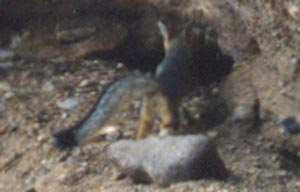
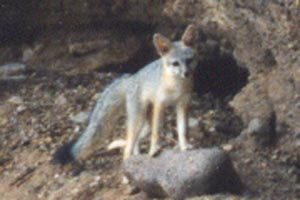
Gray Fox (Urocyon cinereoargenteus)
Main sources: Nowak, Ronald, 1991, Walker's Mammals of the world, Fifth Edition (two vols.), Baltimore: Johns Hopkins University Press; Hoffmeister, D. F., 1986, Mammals of Arizona, Tucson: University of Arizona Press; Burt, W. & R. Grossenheider, eds., 1976, A Field Guide to the Mammals, Peterson Field Guides: Houghton Mifflin; Murie, Olaus, 1974, Animal Tracks, Peterson Field Guides: Houghton Mifflin.
The Gray Fox is a member of a genus that is separate from other foxes of North America (the Red Fox, Kit Fox, Swift Fox), which are members of the Vulpes genus and distinctly North American in their distribution. Our Urocyon cinereoargenteus ranges from Canada to Venezuela, with a sister species limited to several Pacific islands off the California coast. Overall, the Gray Fox is a grizzled grayish in color, and has a line of black hairs running the length of the dorsum of its long bushy tail. The tip of the tail is black. All of these features are evident in the banner photos displayed above, which show one in different stances in front of its den, located along a cliff side. Also evident in our banner photos are a whitish throat, insides of legs, and underparts, while the sides of the neck, lower flanks, and ventral part of the tail are rusty.
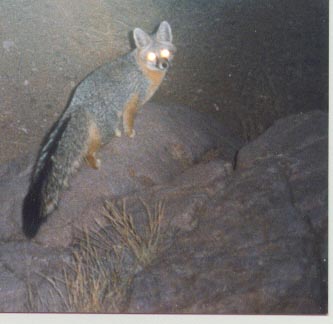 The rusty parts of the coat are more clearly shown in this nighttime photo at left, which also highlights the black hair stripe on the tail.
The rusty parts of the coat are more clearly shown in this nighttime photo at left, which also highlights the black hair stripe on the tail.
The Kit Fox (Vulpes macrotis) -- the other kind of fox found in our area has, in contrast, a pale gray body washed with rust, and even larger ears than those of the Gray Fox. (Burt & Grossenheider 1980:73.) Hoffmeister 1986 emphasizes that its color is buffy (not reddish) -- p.471 -- which clearly distinguishes it from the Gray, which has definitely reddish parts. See the Burt/Grossenheider Plate 7 B though our top-banner. The Gray Fox shows a paler gray back than the one represented in that Plate.
The Gray Fox dens in holes in the ground, rock piles, mine shafts, crevices in cliffs, and hollows in trees, and is principally nocturnal but also often encountered in the early morning or evening twilight. [Hoffmeister 1986:475.] In contrast, Kit Foxes prefer sandy soils where they can dig their dens. These are found in soft, alluvial soils, sand dunes, or easily diggable clay soils, most often in desertscrub or desert grassland. The mounds of dirt excavated from the burrow provide a high spot on what is usually flat terrain. [Ibid.:474.] However, we have seen Gray Fox dens in sandy alluvial soils along the San Pedro River. Indeed, we have yet to identify Kit Foxes in our area.
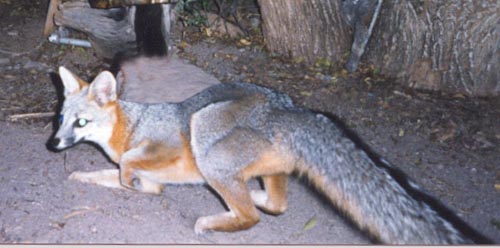 We caught an image of the animal at left close up; here, the reddish ruff, underlegs and sides of belly show very clearly, as does the black stripe on top of the tail. Note also the reddish back of the ears, just
noticeable. The shape of the head is also clearly defined in this image. The skull of the Gray Fox is different from other foxes -- it has pronounced temporal ridges (described in our sources above).
We caught an image of the animal at left close up; here, the reddish ruff, underlegs and sides of belly show very clearly, as does the black stripe on top of the tail. Note also the reddish back of the ears, just
noticeable. The shape of the head is also clearly defined in this image. The skull of the Gray Fox is different from other foxes -- it has pronounced temporal ridges (described in our sources above).
Both of our Fox species eat a wide variety of small fauna (up to the size of jackrabbits), and the Gray Fox (at least) also eats various kinds of berries in season, its scat sometimes appearing full of such seeds. The Gray Fox can run at 28 mph. for short distances (a very impressive speed for an animal of this size). The images below show the corpse of a young animal (apparently drowned in a 1999 flash flood that passed through Upper Cottonwood Seep), displaying a very fierce-looking set of bright teeth:.
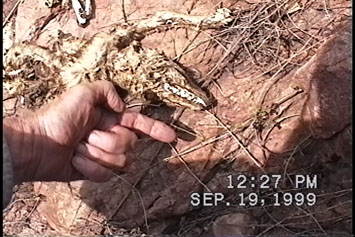
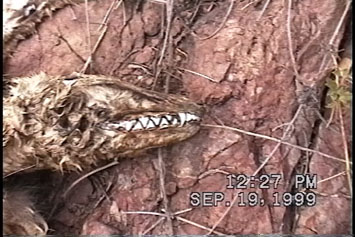
For much more detail on bones, click on Gray Fox Skeleton July 2004.
Below is a fresh track of a gray fox in fine silt along the dirt road in Lower Hot Springs Canyon, seen the morning after a pair's eerie nocturnal cries were heard nearby. The length of the bar code on the lip balm container is just 1 1/4 inches, the typical width of this animal's track (Murie 1974, p. 86).
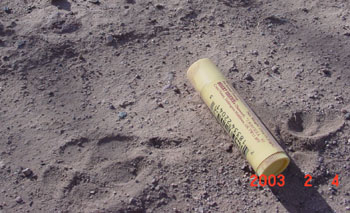
Return to Mammals